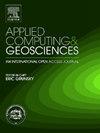Mapping landforms of a hilly landscape using machine learning and high-resolution LiDAR topographic data
IF 3.2
Q2 COMPUTER SCIENCE, INTERDISCIPLINARY APPLICATIONS
引用次数: 0
Abstract
Landform maps are important tools in assessment of soil- and eco-hydrogeomorphic processes and hazards, hydrological modeling, and natural resources and land management. Traditional techniques of mapping landforms based on field surveys or from aerial photographs can be time and labor intensive, highlighting the importance of remote sensing products based automatic or semi-automatic approaches. In addition, the time-intensive manual labeling can also be subjective rather than an objective identification of the landform. Here we implemented such an objective approach applying a random forest machine learning algorithm to a set of observed landform data and 1m horizontal resolution bare-earth digital elevation model (DEM) developed from airborne light detection and ranging (LiDAR) data to rapidly map various landforms of a hilly landscape. The landform classification includes upland plateaus, ridges, convex slopes, planar slopes, concave slopes, stream channels, and valley bottoms, across a 400 km2 hilly landscape of the Ozark Mountains in northeastern Oklahoma. We used 4200 landform observations (600 per landform) and eight topographic indices derived from 2 m, 5 m and 10 m resolution LiDAR DEM in random forest algorithm to develop 2 m, 5 m and 10 m resolution landform models. We test the effectiveness of DEM resolution in mapping landforms via comparison of observed landforms with modeled landforms. Results showed that the approach mapped ∼84% of observed landforms when covariates were at 2 m resolution to ∼89% when they were at 10 m resolution. However, predicted maps showed that the 2 m resolution covariates performed better at capturing accurate landform boundaries and details of small-sized landforms such as stream channels and ridges. The approach presented here significantly reduces the time required for mapping landforms compared to traditional techniques using aerial imagery and field observations and allows incorporation of a wide variety of covariates. The landform map developed using this approach has several potential applications. It could be utilized in hydrological modeling, natural resource management, and characterizing soil-geomorphic processes and hazards in a hilly landscape.
利用机器学习和高分辨率激光雷达地形数据绘制丘陵地貌图
地貌图是评估土壤和生态水文地质过程和危害、水文建模以及自然资源和土地管理的重要工具。基于实地勘测或航拍照片绘制地貌图的传统技术耗时耗力,因此基于遥感产品的自动或半自动方法显得尤为重要。此外,耗时耗力的人工标注也可能是主观的,而不是对地貌的客观识别。在此,我们将随机森林机器学习算法应用于一组观测到的地貌数据和由机载光探测与测距(LiDAR)数据开发的 1 米水平分辨率裸地数字高程模型(DEM),以快速绘制丘陵地形的各种地貌。地貌分类包括俄克拉荷马州东北部奥扎克山脉 400 平方公里丘陵地带的高地高原、山脊、凸坡、平面坡、凹坡、河道和谷底。我们使用 4200 个地貌观测点(每个地貌点 600 个观测点)以及从 2 m、5 m 和 10 m 分辨率的 LiDAR DEM 中提取的 8 个地形指数,通过随机森林算法开发出 2 m、5 m 和 10 m 分辨率的地貌模型。我们通过将观测到的地貌与建模的地貌进行比较,检验了 DEM 分辨率在绘制地貌图方面的有效性。结果表明,当协变量分辨率为 2 米时,该方法绘制了 84% 的观测地貌,而当协变量分辨率为 10 米时,则绘制了 89% 的观测地貌。然而,预测图显示,2 米分辨率的协变量在捕捉准确的地貌边界和小型地貌(如河道和山脊)细节方面表现更好。与使用航拍图像和实地观测的传统技术相比,本文介绍的方法大大缩短了绘制地貌图所需的时间,并可纳入多种协变量。使用这种方法绘制的地貌图有多种潜在应用。它可用于水文建模、自然资源管理以及描述丘陵地带的土壤地貌过程和危害。
本文章由计算机程序翻译,如有差异,请以英文原文为准。
求助全文
约1分钟内获得全文
求助全文
来源期刊

Applied Computing and Geosciences
Computer Science-General Computer Science
CiteScore
5.50
自引率
0.00%
发文量
23
审稿时长
5 weeks
 求助内容:
求助内容: 应助结果提醒方式:
应助结果提醒方式:


